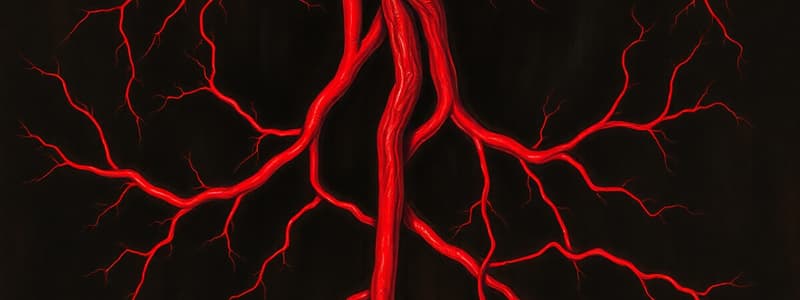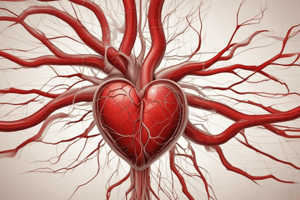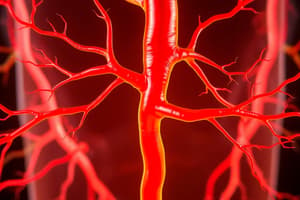Podcast
Questions and Answers
Veins are characterized by having thicker walls and more smooth muscle compared to arteries.
Veins are characterized by having thicker walls and more smooth muscle compared to arteries.
False (B)
Which of the following factors does NOT directly facilitate venous return?
Which of the following factors does NOT directly facilitate venous return?
- Valves within veins
- Arterial vasoconstriction (correct)
- Venous pump mechanism
- Respiratory cycle
Veins contain the highest proportion of blood in the cardiovascular system, approximately ______ percent.
Veins contain the highest proportion of blood in the cardiovascular system, approximately ______ percent.
65
Explain how valves in veins contribute to unidirectional blood flow, particularly in the limbs.
Explain how valves in veins contribute to unidirectional blood flow, particularly in the limbs.
Match the following mechanisms with their primary effect on central venous pressure (CVP):
Match the following mechanisms with their primary effect on central venous pressure (CVP):
Which of the following best describes the pressure gradient that enables blood flow in veins?
Which of the following best describes the pressure gradient that enables blood flow in veins?
Briefly describe the Valsalva maneuver and its direct impact on central venous pressure (CVP).
Briefly describe the Valsalva maneuver and its direct impact on central venous pressure (CVP).
Veins in the skull are prone to collapse due to low pressure.
Veins in the skull are prone to collapse due to low pressure.
Which of the following scenarios would likely result in a DECREASE in central venous pressure (CVP)?
Which of the following scenarios would likely result in a DECREASE in central venous pressure (CVP)?
The venous pump mechanism relies on ______ contraction to compress veins and propel blood toward the heart.
The venous pump mechanism relies on ______ contraction to compress veins and propel blood toward the heart.
What is the primary function of the lymphatic system?
What is the primary function of the lymphatic system?
Lymph is identical in composition to blood plasma, including a similar protein concentration.
Lymph is identical in composition to blood plasma, including a similar protein concentration.
Match the following lymphatic structures with their function:
Match the following lymphatic structures with their function:
What is the average daily volume of lymph flow in the human body?
What is the average daily volume of lymph flow in the human body?
Lymphatic capillaries drain excessive ______ fluid from tissues that has escaped reabsorption from blood capillaries.
Lymphatic capillaries drain excessive ______ fluid from tissues that has escaped reabsorption from blood capillaries.
Which of the following factors facilitates the slow flow of lymph?
Which of the following factors facilitates the slow flow of lymph?
The thoracic duct drains lymph from the entire right side of the body, including the right arm and right side of the head.
The thoracic duct drains lymph from the entire right side of the body, including the right arm and right side of the head.
Describe the role of edema in relation to the lymphatic system.
Describe the role of edema in relation to the lymphatic system.
The nodules of lymphoid tissue found in the wall of the intestinal tract are known as ______.
The nodules of lymphoid tissue found in the wall of the intestinal tract are known as ______.
Which of these statements best describes the structural difference between veins and arteries?
Which of these statements best describes the structural difference between veins and arteries?
Increasing blood volume typically leads to a decrease in central venous pressure (CVP).
Increasing blood volume typically leads to a decrease in central venous pressure (CVP).
Match each of the following mechanism with its effect on venous return.
Match each of the following mechanism with its effect on venous return.
The normal pressure in the right atrium is approximately ______ mmHg.
The normal pressure in the right atrium is approximately ______ mmHg.
How do valves function in the veins of lower limbs to regulate bloodflow?
How do valves function in the veins of lower limbs to regulate bloodflow?
Why is the compliance of veins important for venous return?
Why is the compliance of veins important for venous return?
Flashcards
Veins
Veins
Blood vessels that return blood to the heart.
Valves in Veins
Valves in Veins
Veins have these to prevent backflow, especially in limbs.
Varicose Veins
Varicose Veins
Bulging, twisted veins caused by valve failure.
Venous Pump
Venous Pump
Signup and view all the flashcards
Central Venous Pressure
Central Venous Pressure
Signup and view all the flashcards
Decreased Cardiac Output
Decreased Cardiac Output
Signup and view all the flashcards
Increased Blood Volume
Increased Blood Volume
Signup and view all the flashcards
Venous Constriction
Venous Constriction
Signup and view all the flashcards
Standing to Supine position
Standing to Supine position
Signup and view all the flashcards
Arterial Dilation
Arterial Dilation
Signup and view all the flashcards
Valsalva maneuver
Valsalva maneuver
Signup and view all the flashcards
Muscle Contraction
Muscle Contraction
Signup and view all the flashcards
Lymphatic System
Lymphatic System
Signup and view all the flashcards
Lymph
Lymph
Signup and view all the flashcards
Thoracic duct drains into
Thoracic duct drains into
Signup and view all the flashcards
Right lymphatic duct drains into
Right lymphatic duct drains into
Signup and view all the flashcards
Functions of Lymph
Functions of Lymph
Signup and view all the flashcards
Oedema
Oedema
Signup and view all the flashcards
Study Notes
Veins
- Veins are thin-walled
- Veins contain less smooth muscle than arteries
- The sympathetic nervous system (SNS), catecholamines and Angiotensin II (ANG II) impact venous smooth muscle
- Veins are under low pressure
- Veins contain the highest proportion of blood in the cardiovascular system, 65%
- Veins can constrict and enlarge
- Veins are compliant and deformable
Blood Flow in Veins
- Blood flow is enabled by the pressure gradient between venules (10-15 mmHg) and the right atrium (0 mmHg)
- Blood flow exhibits low resistance (R) and a low pressure gradient
- Venous return is facilitated by valves, the venous pump, the respiratory cycle, ejection phase of the cardiac cycle, venoconstriction, and the arrangement of vessels
Valves in Veins
- Veins in limbs have valves that enable unidirectional blood flow
- Valves decrease the effective hydrostatic pressure by dividing the vertical column into shorter segments
Varixes
- Veins can become varicose
Venous Pump
- Muscle contraction compresses veins, squeezing blood out
- Valves allow blood to flow only toward the heart
Central Venous Pressure
- Central venous pressure (CVP) is the pressure in the right atrium
- CVP is regulated by the balance between the heart's ability to pump blood out of the right atrium/ventricle and blood flow from peripheral veins into the right atrium
- Normal right atrial pressure is around 0 mmHg
- Factors influencing CVP affect either the compliance of veins or blood volume
Factors Increasing Central Venous Pressure
- Decreased cardiac output increases blood volume
- Increased blood volume increases blood volume
- Venous constriction increases venous compliance
- Changing from standing to supine body posture increases blood volume
- Arterial dilation increases blood volume
- Forced expiration, i.e. Valsalva, increases venous compliance
- Muscle contraction increases blood volume, venous compliance
Impact of Physiological Events on CVP
- Decreased cardiac output results in blood backing up into the venous circulation, increasing venous volume and thoracic blood volume, and CVP
- Increased total blood volume, as in renal failure, increases venous pressure
- Venous constriction from sympathetic activation decreases venous compliance, increasing venous pressure
- Shifting blood volume into the thoracic venous compartment when changing from standing to supine position increases CVP
- Arterial dilation from withdrawal of sympathetic tone increases blood flow from the arterial to venous compartments, increasing venous volume and CVP
- Central venous pressure (CVP) increases during forced expiration against high resistance (Valsalva maneuver) due to external compression of the thoracic vena cava as intrapleural pressure rises
- Muscle contraction compresses veins, decreasing compliance, and forces blood into the thoracic compartment
Effect of Gravitational Pressure on Venous Pressure
- Pressure results from the weight of blood in the vessels
- Veins in the skull are in the noncollapsible chamber
Lymphatic System Components
- This system includes lymphatic circulation and lymphoid tissues
- Primary and secondary lymphoid organs are part of the lymphatic system
- Bone marrow, thymus, spleen, lymph nodes, tonsils (Waldeyer's ring), appendix (tonsila abdominalis), and gut-associated lymphatic tissue (GALT) are components
Function of Lymphatic System
- A network of lymphatic vessels and lymph nodes that perform filtration of lymph, phagocytosis of foreign particles, and formation of antibodies
- Lymph is derived from interstitial fluid, has a similar composition to plasma, with a protein concentration of only 20 g/l
Lymphatic Ducts
- The thoracic duct connects to the junction of the left internal jugular and left subclavian veins
- The right lymphatic duct connects to the junction of the right internal jugular and right subclavian veins
Lymph System Stats
- 20 L of fluid is filtered from capillaries per day
- 16-18 L of volume is reabsorbed in capillaries per day
- Lymph flow is 2-4 L/day
Lymph System Functions
- Drainage occurs for water and macromolecular substances from the interstitium
- Neutral fat is absorbed from the GIT
- Immunological roles exist in lymph nodes
Lymph Formation
- Lymphatic capillaries drain excessive interstitial fluid (2-4 L) that escaped from reabsorption in capillaries daily
- Lymph flow is slow, facilitated by smooth muscle contractions, one-way flap valves, skeletal muscle contractions, arterial pulsation and respiration
Studying That Suits You
Use AI to generate personalized quizzes and flashcards to suit your learning preferences.




